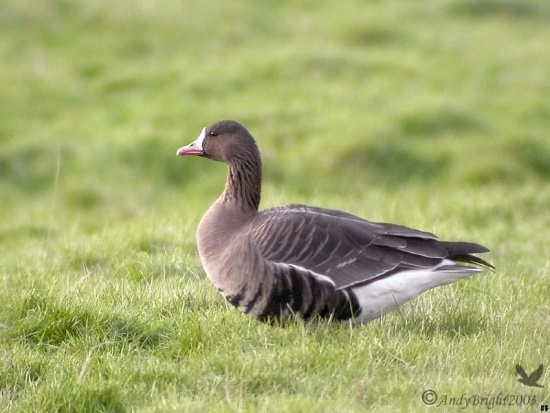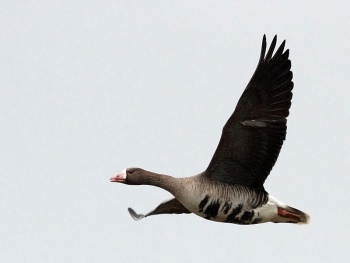(Taxonomy & Behaviour expanded. References. Incomplete gone) |
Nutcracker (talk | contribs) (more details) |
||
| Line 1: | Line 1: | ||
| − | [[Image:Greater_White-fronted_Goose.jpg|thumb|550px|right|Photo by {{user|Andy+Bright|Andy Bright}}]] | + | [[Image:Greater_White-fronted_Goose.jpg|thumb|550px|right|Adult ''A. a. albifrons''. Photo by {{user|Andy+Bright|Andy Bright}}]] |
;[[:Category:Anser|Anser]] albifrons | ;[[:Category:Anser|Anser]] albifrons | ||
==Identification== | ==Identification== | ||
| − | '''Adult''': white | + | '''Adult''': a medium-sized grey goose with a stout bill. Has a white forehead that does not continue up onto the crown, and black bars on the belly. Legs bright orange; bill pink or orange (see subspecies, below). Eye dark, usually with no visible eye ring. |
| + | '''Juvenile''': plainer grey without white or black; the white forehead and black belly bars moult in steadily through the first winter and are usually fully developed by the time they migrate north in spring. Bill less brightly coloured, smudged blackish. | ||
| − | + | [[Image:IMG 96173.jpg|thumb|350px|right|Adult ''A. a. albifrons''. Photo by {{user|Macswede|Macswede}}<br />Skåne, [[Sweden]], April 2012]] | |
| − | [[Image:IMG 96173.jpg|thumb|350px|right|Photo by {{user|Macswede|Macswede}}<br />Skåne, [[Sweden]], April 2012]] | ||
====Similar Species==== | ====Similar Species==== | ||
| − | [[Lesser White-fronted Goose]] is the main contender, | + | The [[Lesser White-fronted Goose]] is the main contender, differing in its small size, small stubby bill, bright yellow eye ring, and more extensive white on the forehead extending to the crown. |
| + | |||
| + | Immature birds, lacking the white forehead and black barring, may be mistaken for a number of other species, notably [[Taiga Bean Goose]] and [[Tundra Bean Goose]]; they can usually be distinguished easily as their adult parents will be nearby, but lone lost individuals are more difficult - the best feature is the fairly plain grey neck and head, less contrasting than the dark necks and heads of the two bean goose species. | ||
| + | |||
| + | Partially white domesticated [[Greylag Goose|Greylag Geese]] with a white base around the bill are a common source of confusion for novices; they can be told by their much larger size, and (as typical of domesticated geese), very fat, heavy rear parts and more upright stance, and confiding behaviour (White-fronted Geese are usually quite wary). | ||
| + | |||
==Distribution== | ==Distribution== | ||
Has an almost circumpolar breeding distribution, from northern [[Russia]] through [[Siberia]], [[Alaska]], and [[Canada]] to [[Greenland]]. | Has an almost circumpolar breeding distribution, from northern [[Russia]] through [[Siberia]], [[Alaska]], and [[Canada]] to [[Greenland]]. | ||
| − | In winter it migrates south but in some cases at the same time strongly east or west of due south; for example the Greenland subspecies winters | + | In winter it migrates south but in some cases at the same time strongly east or west of due south; for example the Greenland subspecies winters migrates southeast, and western Russian populations of the nominate subspecies migrate west-south-west. Other populations come south to western and southern [[Europe]], [[China]], and [[Mexico]]. |
| + | |||
==Taxonomy== | ==Taxonomy== | ||
| − | Five subspecies are | + | Five subspecies are currently recognised<sup>[[#References|[1]]]</sup><sup>[[#References|[2]]]</sup><sup>[[#References|[3]]]</sup><sup>[[#References|[4]]]</sup>: |
| − | *''A. a. albifrons'': Eurasian | + | *''A. a. flavirostris'': Greenland White-fronted Goose |
| − | : | + | ::Breeds on the west coast of [[Greenland]]; winters mainly in [[Ireland]] and western [[Scotland]], also rarely in [[Wales]], northern [[England]], and the east coast of the [[USA]]. |
| − | *''A. a. | + | *''A. a. albifrons'': Eurasian White-fronted Goose |
| − | : | + | ::Northern [[Russia]] and [[Siberia]]; winters southwest to southern [[England]], the [[Mediterranean]], [[Iraq]], southeast [[China]], [[South Korea]], and southern [[Japan]]. |
| − | *''A. a. gambelli'': | + | *''A. a. elgasi'': Tule White-fronted Goose |
| − | : | + | ::Taiga in south of Alaska near Anchorage; winters in Sacramento Valley, [[California]]. |
| − | *''A. a. | + | *''A. a. gambelli'': Gambell's White-fronted Goose |
| − | : | + | ::Taiga of north-western [[Canada]] and western [[Alaska]]; winters south-central [[USA]], northeast [[Mexico]] (includes the type specimen of ''A. a. frontalis''). |
| − | + | *''A. a. sponsa'': Pacific White-fronted Goose | |
| − | + | ::Western [[Alaska]]; winters western [[USA]] and northwest [[Mexico]] (synonym ''A. a. frontalis'' as to popular usage, but not type specimen<sup>[[#References|[3]]]</sup>). | |
| + | |||
| + | The Greenland subspecies (Greenland White-fronted Goose ''A. a. flavirostris'') is the most distinctive, with much darker plumage overall and only a very narrow white tip to the tail feathers, and also the bill is yellow-orange (the other subspecies all have a pink bill). It also differs in behaviour, with exceptionally persistent family relationships including grandparenting<sup>[[#References|[5]]]</sup>; it may be better treated as a separate species<sup>[[#References|[5]]]</sup>. The other subspecies differ slightly in size, with ''A. a. elgasi'' the largest and heaviest-billed, and ''A. a. albifrons'' the smallest. ''A. a. elgasi'' can also show a narrow yellow eye ring as in [[Lesser White-fronted Goose]], though its much larger body and bill size makes confusion improbable. | ||
==Habitat== | ==Habitat== | ||
| − | They breed in areas of open tundra, near bogs and marshes. In winter they use lakes and rivers, usually near coasts. | + | They breed in areas of open tundra, near bogs and marshes. In winter they use rough grassland, saltmarsh, lakes and rivers, usually near coasts. |
==Behaviour== | ==Behaviour== | ||
====Diet==== | ====Diet==== | ||
| − | Almost entirely herbivorous. They eat a wide variety of plant matter from roots through stems, seeds berries and also potatoes and grain. | + | Almost entirely herbivorous. They eat a wide variety of plant matter from roots through stems, seeds, berries, and also potatoes and grain. |
====Vocalisation==== | ====Vocalisation==== | ||
<flashmp3>Anser albifrons (song).mp3</flashmp3><br /> | <flashmp3>Anser albifrons (song).mp3</flashmp3><br /> | ||
''[[Media:Anser albifrons (song).mp3|Listen in an external program]]'' | ''[[Media:Anser albifrons (song).mp3|Listen in an external program]]'' | ||
==References== | ==References== | ||
| − | #{{Ref-Clements6thAug14}}#Handbook of the Birds of the World Alive (retrieved September 2014) | + | #{{Ref-GillDonsker14V4.3}}#{{Ref-Clements6thAug14}}#Banks, R. C. (2011). Taxonomy of Greater White-fronted Geese (Aves: Anatidae). ''Proceedings of the Biological Society of Washington'' [http://www.jeaniron.ca/2011/Banks-GWFG-PBSW-11.pdf 124 (3): 226-233]. |
| + | #[https://commons.wikimedia.org/wiki/File:Anser_albifrons_map.png Distribution map] | ||
| + | #Fox, A. D., & Stroud, D. A. (2002). ''Anser albifrons flavirostris'' Greenland White-fronted Goose. ''BWP Update'' 4 (2): 65-88. | ||
| + | #Handbook of the Birds of the World Alive (retrieved September 2014) | ||
{{ref}} | {{ref}} | ||
==External Links== | ==External Links== | ||
Revision as of 12:23, 1 November 2014

- Anser albifrons
Identification
Adult: a medium-sized grey goose with a stout bill. Has a white forehead that does not continue up onto the crown, and black bars on the belly. Legs bright orange; bill pink or orange (see subspecies, below). Eye dark, usually with no visible eye ring. Juvenile: plainer grey without white or black; the white forehead and black belly bars moult in steadily through the first winter and are usually fully developed by the time they migrate north in spring. Bill less brightly coloured, smudged blackish.
Similar Species
The Lesser White-fronted Goose is the main contender, differing in its small size, small stubby bill, bright yellow eye ring, and more extensive white on the forehead extending to the crown.
Immature birds, lacking the white forehead and black barring, may be mistaken for a number of other species, notably Taiga Bean Goose and Tundra Bean Goose; they can usually be distinguished easily as their adult parents will be nearby, but lone lost individuals are more difficult - the best feature is the fairly plain grey neck and head, less contrasting than the dark necks and heads of the two bean goose species.
Partially white domesticated Greylag Geese with a white base around the bill are a common source of confusion for novices; they can be told by their much larger size, and (as typical of domesticated geese), very fat, heavy rear parts and more upright stance, and confiding behaviour (White-fronted Geese are usually quite wary).
Distribution
Has an almost circumpolar breeding distribution, from northern Russia through Siberia, Alaska, and Canada to Greenland.
In winter it migrates south but in some cases at the same time strongly east or west of due south; for example the Greenland subspecies winters migrates southeast, and western Russian populations of the nominate subspecies migrate west-south-west. Other populations come south to western and southern Europe, China, and Mexico.
Taxonomy
Five subspecies are currently recognised[1][2][3][4]:
- A. a. flavirostris: Greenland White-fronted Goose
- A. a. albifrons: Eurasian White-fronted Goose
- Northern Russia and Siberia; winters southwest to southern England, the Mediterranean, Iraq, southeast China, South Korea, and southern Japan.
- A. a. elgasi: Tule White-fronted Goose
- Taiga in south of Alaska near Anchorage; winters in Sacramento Valley, California.
- A. a. gambelli: Gambell's White-fronted Goose
- A. a. sponsa: Pacific White-fronted Goose
The Greenland subspecies (Greenland White-fronted Goose A. a. flavirostris) is the most distinctive, with much darker plumage overall and only a very narrow white tip to the tail feathers, and also the bill is yellow-orange (the other subspecies all have a pink bill). It also differs in behaviour, with exceptionally persistent family relationships including grandparenting[5]; it may be better treated as a separate species[5]. The other subspecies differ slightly in size, with A. a. elgasi the largest and heaviest-billed, and A. a. albifrons the smallest. A. a. elgasi can also show a narrow yellow eye ring as in Lesser White-fronted Goose, though its much larger body and bill size makes confusion improbable.
Habitat
They breed in areas of open tundra, near bogs and marshes. In winter they use rough grassland, saltmarsh, lakes and rivers, usually near coasts.
Behaviour
Diet
Almost entirely herbivorous. They eat a wide variety of plant matter from roots through stems, seeds, berries, and also potatoes and grain.
Vocalisation
<flashmp3>Anser albifrons (song).mp3</flashmp3>
Listen in an external program
References
- Gill, F and D Donsker (Eds). 2014. IOC World Bird Names (version 4.3). Available at http://www.worldbirdnames.org/.
- Clements, J. F., T. S. Schulenberg, M. J. Iliff, D. Roberson, T. A. Fredericks, B. L. Sullivan, and C. L. Wood. 2014. The eBird/Clements checklist of birds of the world: Version 6.9., with updates to August 2014. Downloaded from http://www.birds.cornell.edu/clementschecklist/download/
- Banks, R. C. (2011). Taxonomy of Greater White-fronted Geese (Aves: Anatidae). Proceedings of the Biological Society of Washington 124 (3): 226-233.
- Distribution map
- Fox, A. D., & Stroud, D. A. (2002). Anser albifrons flavirostris Greenland White-fronted Goose. BWP Update 4 (2): 65-88.
- Handbook of the Birds of the World Alive (retrieved September 2014)
Recommended Citation
- BirdForum Opus contributors. (2024) Greater White-fronted Goose. In: BirdForum, the forum for wild birds and birding. Retrieved 26 April 2024 from https://www.birdforum.net/opus/Greater_White-fronted_Goose




